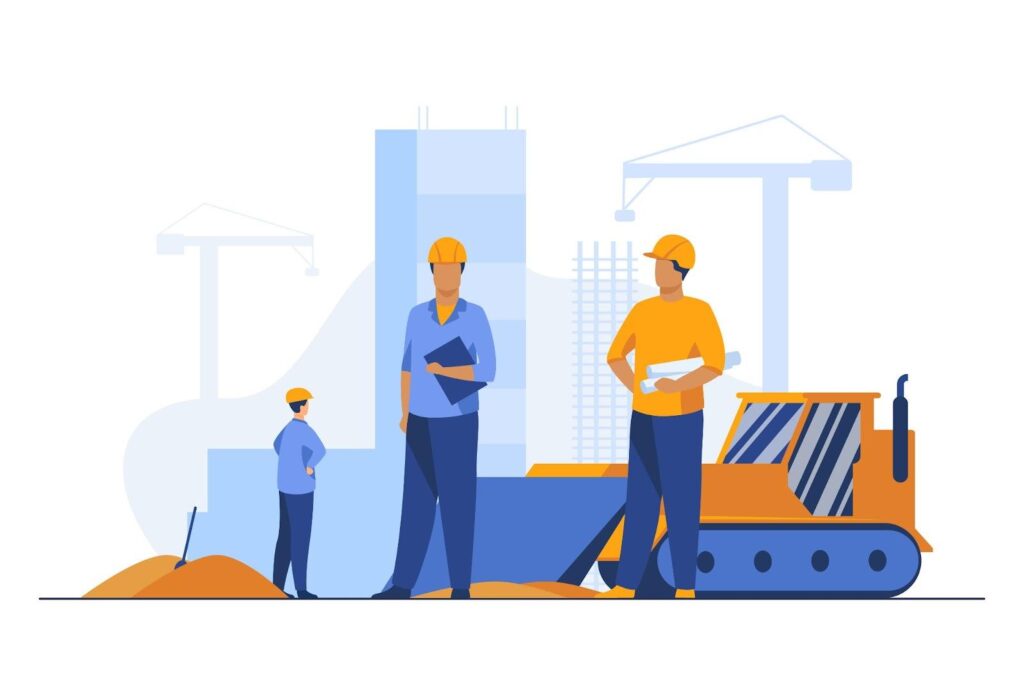What comes to mind when you think about the role of construction in your daily life? From the homes we inhabit to the offices where we work, the structures around us significantly shape our experiences and interactions. It’s intriguing to explore the differences between residential and commercial construction and how each sector contributes to our communities, notes Mabry Management team.
For instance, residential construction revolves around creating homes and apartments that serve as the backdrop for our personal lives, while commercial construction focuses on building office spaces, retail locations, and public facilities that shape the business landscape. Each type of construction faces its own set of challenges and trends that influence the industry.
As you consider these aspects, what do you find most compelling about construction and its impact on our lives? Let’s explore this topic further together!
Residential Construction
Residential construction refers to building houses, apartment complexes, townhouses, and other structures where people live. This type of construction caters to individual or family needs and focuses on creating safe, comfortable, and functional living spaces.
Types of Residential Buildings
- Single-Family Homes: These are detached structures designed to house one family. Single-family homes are often built in suburban or rural areas and are typically associated with large yards, driveways, and private entrances.
- Multi-Family Homes: These structures house more than one family in separate living spaces. They include duplexes, triplexes, and apartment buildings, often found in urban areas where space is limited.
- Condominiums: Condos are individually owned units within a larger building. They often offer amenities such as shared swimming pools, gyms, and concierge services. The building itself is typically managed by a homeowners association (HOA).
- Townhouses: These are multi-story homes that share walls with adjacent properties but have their private entrances. They are often located in densely populated areas and offer a blend of the benefits of detached homes and apartments.
Process of Residential Construction

The process of residential construction typically involves several key steps:
- Planning and Design: The first stage involves understanding the client’s needs and designing a suitable structure. Architects and designers create blueprints and plans, considering the local building codes, zoning regulations, and environmental factors.
- Permits and Approvals: Before construction can begin, local authorities must obtain necessary permits. These permits ensure that the building will meet safety and environmental standards.
- Site Preparation: Once the permits are in place, the site is cleared and prepared for construction. This includes grading the land, installing temporary utilities, and ensuring proper drainage.
- Foundation: The foundation is one of the most crucial parts of any residential building. It supports the structure and must be built to withstand local soil conditions and environmental factors. Foundations, including slab foundations, crawl spaces, or basements, can vary.
- Framing: This step involves constructing the house’s skeleton. Wooden or steel beams and columns frame the structure, including walls, floors, and roofs.
- Plumbing, Electrical, and HVAC: With the frame in place, the next phase includes installing plumbing, electrical wiring, heating, ventilation, and air conditioning (HVAC) systems. These systems must be carefully integrated into the structure and are subject to strict regulations.
- Interior and Exterior Finishing: Once the essential systems are in place, contractors can proceed with finishing the interior and exterior of the building. This includes drywall installation, painting, flooring, cabinetry, roofing, and siding. One important step in enhancing the exterior aesthetic and providing added durability is applying a high-quality cement rendering, which gives the walls a smooth, weather-resistant finish and adds to the property’s curb appeal.
- Final Inspection and Handover: After the construction, the building undergoes a final inspection to ensure it meets all safety and quality standards. Once approved, the property is handed over to the owner.
Trends in Residential Construction

In recent years, several trends have emerged in residential construction, reflecting changes in consumer preferences and technological advancements:
- Sustainable Building Practices: There is a growing demand for eco-friendly homes, that emphasize energy efficiency, renewable energy sources, and sustainable building materials. Solar panels, smart home technology, and water-saving fixtures are standard features in many new homes.
- Tiny Homes and Modular Homes: As housing prices continue to rise, tiny and modular homes are gaining popularity. These homes are smaller, more affordable, and can be built faster than traditional homes.
- Smart Homes: With the rise of the Internet of Things (IoT), more homes are incorporating smart technology. From voice-activated assistants to automated lighting and security systems, homeowners increasingly integrate technology to enhance convenience and efficiency.
Commercial Construction
Commercial construction involves building structures used for business purposes, such as office buildings, retail stores, warehouses, hotels, and other commercial properties. Unlike residential construction, which focuses on individual needs, commercial construction is more complex and often involves larger-scale projects that require significant planning and investment.
Types of Commercial Buildings
- Office Buildings: These buildings provide workspaces for businesses and organizations. They can vary in size from small, single-story buildings to high-rise skyscrapers. Modern office buildings often feature open floor plans, green spaces, and sustainable design elements.
- Retail Spaces: Retail buildings include shopping malls, department stores, and standalone shops. These spaces are designed to accommodate businesses that sell goods or services to the public.
- Industrial Buildings are large structures used for manufacturing, storage, or distribution. They may include factories, warehouses, and distribution centers.
- Hospitality: Hotels, resorts, and other hospitality venues fall under commercial construction. These buildings are designed to offer accommodations and services for travelers and tourists.
- Healthcare Facilities: Hospitals, clinics, and other healthcare-related buildings require specialized construction to meet the needs of patients, healthcare professionals, and support staff.
- Educational Buildings: Schools, universities, and training centers are also part of the commercial construction sector. These buildings are designed to facilitate learning and provide classrooms, laboratories, and administrative spaces.
Process of Commercial Construction
Commercial construction is often more intricate and involves more stakeholders than residential construction. The process can take months or even years, depending on the size and scope of the project:
- Pre-Construction Phase: Like residential construction, commercial construction begins with planning, design, and permitting. In this phase, architects, engineers, and contractors collaborate to create detailed plans and obtain necessary approvals.
- Budgeting and Financing: Commercial construction projects usually require significant financing involving loans or investments from multiple sources. Budgeting is a critical aspect of the process to ensure that the project stays within financial constraints.
- Site Preparation and Excavation: Similar to residential construction, commercial projects begin with site preparation. However, this phase may involve extensive excavation, demolition of existing structures, and soil testing due to the larger scale.
- Foundation and Structural Work: Due to their size and the weight they must support, commercial buildings often require more robust foundations. These can include deep foundations, such as piles or caissons, or slab foundations. The structural work involves steel framing, concrete pouring, and the construction of floors and walls.
- Mechanical, Electrical, and Plumbing Systems: This phase involves installing the building’s core systems, including HVAC, plumbing, electrical wiring, and fire protection systems. The complexity of these systems often requires careful coordination to ensure they function efficiently.
- Interior and Exterior Finishing: Once the structure is in place, contractors work on the exterior facade, including glass, stone, or other materials. Interior finishing involves installing ceilings, walls, flooring, and furnishings and incorporating specialized features such as security systems or elevators.
- Final Inspections and Handover: Similar to residential construction, commercial projects undergo a final inspection to ensure compliance with codes and regulations. Once approved, the building is handed over to the owner or tenant.
Trends in Commercial Construction
Several emerging trends are shaping the future of commercial construction:
- Sustainability and Green Building: Like residential construction, sustainability is a growing concern in the commercial sector. Green buildings that reduce energy consumption, utilize renewable resources, and minimize waste are increasingly popular. LEED (Leadership in Energy and Environmental Design) certification is becoming a standard for many commercial buildings.
- Smart Buildings: Technology integration into commercial buildings is on the rise. Smart buildings use sensors and automated systems to monitor and control lighting, HVAC, security, and energy usage, enhancing operational efficiency and tenant comfort.
- Modular and Prefabricated Construction: Prefabricated construction, in which building components are manufactured off-site and assembled on location, is gaining popularity. This approach reduces construction time and costs and minimizes environmental impact.
- Workplace Flexibility: How people work is changing, and commercial spaces are adapting. Open-plan offices, collaborative workspaces, and flexible layouts are now standard in many office buildings to promote creativity, collaboration, and employee well-being.
Challenges in Residential and Commercial Construction

Both residential and commercial construction face common challenges, although the scale and scope of these challenges may differ.
- Labor Shortages: Both sectors face shortages of skilled labor, making it harder to find qualified workers. This is exacerbated by the aging workforce and a lack of interest in trades such as carpentry, plumbing, and electrical work.
- Rising Material Costs: The cost of building materials, including lumber, steel, and concrete, has increased in recent years, making it more difficult for construction projects to stay within budget.
- Regulatory Compliance: Both residential and commercial construction are heavily regulated, and compliance with local, state, and federal building codes can be a significant challenge. Failure to meet these regulations can result in delays, fines, or legal action.
- Environmental Impact: As the construction industry grows, so does its environmental impact. From carbon emissions to waste production, the sector must find ways to reduce its ecological footprint.
Conclusion
Residential and commercial construction are integral to society’s development, providing the infrastructure necessary for people to live, work, and interact. While both sectors share some similarities, they have unique requirements and challenges. By understanding the processes, trends, and obstacles these industries face, stakeholders can better navigate the complex world of construction and build the structures that will shape the future.


More Stories
Tips for Home Purchasers in San Antonio
Ntrffee: The Ultimate Guide to a Revolutionary Beverage
Key Features That Make Small Chop Saws a Great Investment for Precision and Value